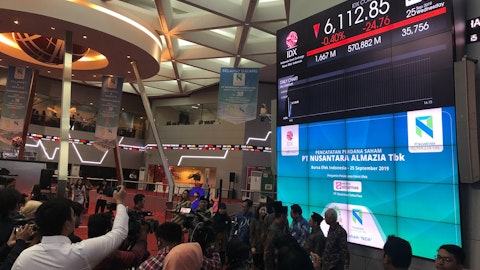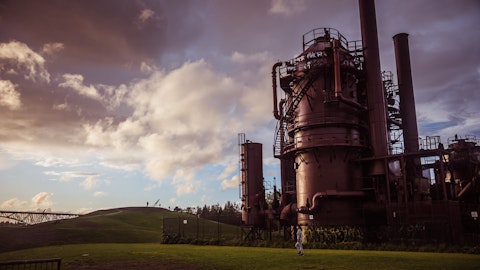Jason Fraser: Yes, I’ll give a little context quarter, we did beat a goal, which will kind of change in how we look at things. So, back prior to the pandemic, we were frequently at the high end or even above our target return payout range of 40% to 50%. Now, during the pandemic, we were very committed to our dividend and paying the dividend loan put us way above our 40% to 50% target range. And as you know, during COVID, we had to take on another $4 billion of debt in 2020. So, one of our main objectives as the financial situations improve post-COVID was the payback this incremental debt, which we’ve been aggressively working on. And we’ve messaged that while we’re working on this competing goal of deleveraging, we would stay at the lower end of our 40% to 50% payout range, which is what we’ve been doing.
Now, in the fourth quarter, we were able to repurchase $442 million of debt, which is the final step in us meeting our goal of deleveraging by $4 billion. So, with that insight, during the quarter, we increased our stock purchases to $1.8 billion and we’re able to end the year at a 45% payout ratio. So, we’re able to work our way back to the midpoint of our target range for the full year. And now that we’ve paid off our pandemic debt and build our cash balance up to a good level, you should reasonably expect us to be looking at mid-level or higher payout targets given the construction margin environment as we move forward. Now, on the dividend side, please go ahead — yes, you’d asked about dividend too, which is other pieces of the puzzle.
So, we continue to aim for a dividend as sustainable and competitive versus our peers. We would also like to show growth. And as you know, the dividends — we hadn’t had any growth since the first quarter of 2020 because, first of all, we had the pandemic, which we had to work our way through. And then we’re rebuilding cash and working our debt down. So, now, as I’ve said, we’ve kind of met those goals so we would like to return to a pattern of growth as we move forward.
Doug Leggate: I appreciate the full answer, Jason. As you know, Joe, we’d like to see cash on the balance sheet. So, thanks so much for that. All the best.
Joe Gorder: Net zero debt, Doug.
Doug Leggate: Thank you everybody.
Operator: Thank you. The next question is coming from Roger Read of Wells Fargo. Please go ahead.
Roger Read: Yes, good morning. I guess I’d like to jump in here on just, call it, crude structure in the market, right? We had big SPR releases a lot of last year. Those seem to have at least, I don’t know if I’d say ceased, they’ve definitely eased quite a bit. You mentioned the Russian sanctions coming up. That’s really more of a product thing. And then we’ve had the Venezuelan barrels start to enter the Gulf of Mexico. So, I guess as a broad question, how are you looking at crude availability and crude dips as we get into the early days of 2023 here?
Gary Simmons: Yes. So, this is Gary. I think our outlook on crude quality differentials is we expect the market to stay fairly consistent. The key drivers really on the quality differentials have been more sour crude on the market, refineries running at high utilization rates, which produce more high sulfur fuel oil. And then with the IMO 2020 regulation, it’s decreased the demand for high sulfur fuel oil. And so all those factors come into play, affecting the supply/demand balances around high sulfur fuel and then high sulfur fuel really drives the quality discount. So we don’t see much changing at least in the near-term in terms of where those quality differentials are.
Roger Read: And as a follow-up on that, I think, Joe, you mentioned with the Russian ban, we might see less VGO in the market. Maybe, Gary, those were your comments. If there’s less VGO in the Atlantic Basin in general, what is your expectation for substitute feedstock into the summer of the secondary units and the kind of follow-on impacts on distillate production?
Lane Riggs: Hey, Roger, this is Lane. I’ll take a shot at it. I think what you’ll see, and we were concerned about it going into this past year was the VGO availability, but we sort of through with some of the way some of the refineries in the Middle East started up. And I think some people stockpiled VGO, I mean, the answer to that is it will remain tight. And ultimately, what it affects is gasoline production. If you believe distillate cracks are going to hang in there where they are, you’ll have clear margins by VGO into a hydrocracker, but it will challenge FCC’s economics through the summer, it’s in fact, as it gets tight.
Roger Read: Great. I’ll €“ that’s my two, so I’ll leave it there. Thank you.
Lane Riggs: Thanks, Roger.
Operator: Thank you. The next question is coming from John Royall of JPMorgan. Please go ahead.
John Royall: Hey, guys. Good morning. Thanks for taking my question. So I was hoping for your view on China reopening and how that could trickle through the market, particularly when you think about the new refining capacity coming on and they appear to still be releasing big batches of export quota. So anything on China reality would be helpful? Thanks.
Gary Simmons: Yeah. So this is Gary. I think we’ve certainly seen the Chinese more active in the market, both purchasing feedstocks and in the product markets as well. It looks to us like a lot of the product exports from China are staying in the region, although we occasionally see some exports making their way into our market. But our view is that, you’ll see significant demand recovery in China by the second quarter. And a lot of that ramp-up in refinery utilization in China will be needed to supply the domestic demand. On the new refinery capacity, at least our supply-demand balances still show year-over-year demand will outpace capacity additions. And so we’re not too concerned about it. A lot of that capacity really doesn’t make a lot of transportation fuels. Some of the big refineries in China, it’s less than 50% total gasoline, jet and diesel yield, a lot more petrochemicals and fuel oil production.
John Royall: Great. Thank you. That’s helpful. And then on the Renewable Diesel side, can you talk about how the feedstock market is absorbing DGD 3 and assuming this is the case, why it’s been kind of easier than having pushed up advantaged feedstock the way it did with DGD 2?
Eric Fisher: Yeah, this is Eric. We haven’t really seen a big change in feedstock costs with DGD 3 coming on. As you said, we did see a big change where waste oil feeds really equilibrated to soybean oil with DGD 2 in 2021. But with the start-up of DGD 3, we’ve seen prices hold pretty flat. We saw that soybean oil actually, at least CBOT €œsoybean oil€, came pretty flat to waste oils in October and November. But then we saw the €œsoybean oil€ drop really with the EPA announcement on their RFS obligations for the next three years. And so €“ but overall, to answer your question, we haven’t seen a big change in feedstock prices. It’s been pretty stable.





